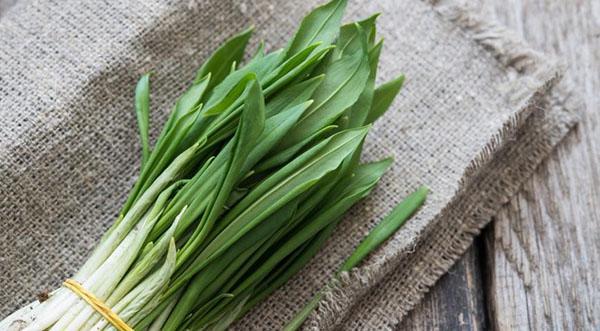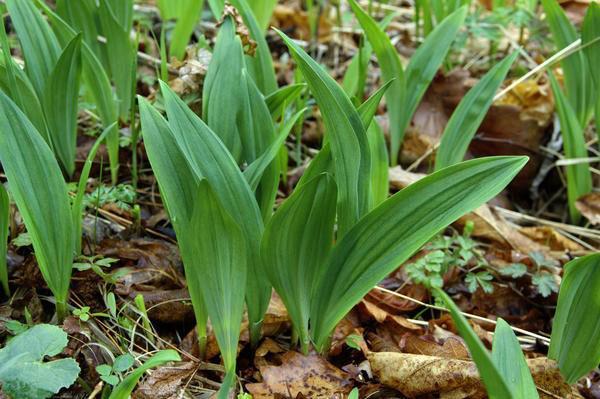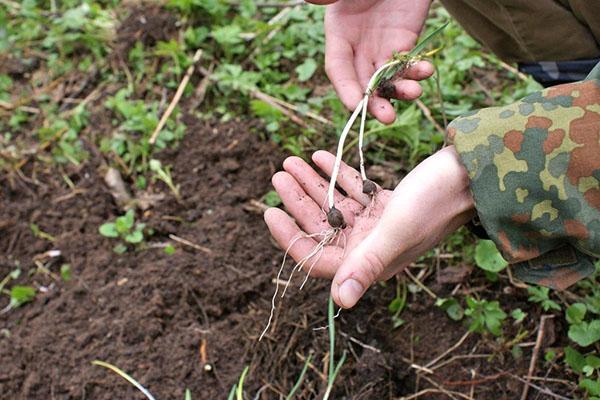How to grow wild garlic at home and at their summer cottage
 Vitamin spring greens are always desirable on the dinner table. Not so long ago, wild garlic has become very popular - a delicate salad herb with a garlic flavor and aroma. To replenish vitamins, diversify the diet and update the range of healthy herbs in the garden, you need to know how to grow wild garlic.
Vitamin spring greens are always desirable on the dinner table. Not so long ago, wild garlic has become very popular - a delicate salad herb with a garlic flavor and aroma. To replenish vitamins, diversify the diet and update the range of healthy herbs in the garden, you need to know how to grow wild garlic.
What is wild garlic

The wild garlic is prized for its delicious greens with a light garlic aroma. Young leaves have a record high amount of ascorbic acid, as well as amino acids and bioflavonoids. After studying the composition and useful properties of the plant, its wild thickets began to quickly disappear due to active collection along with the bulbs. Today wild garlic is listed in the Red Book of many countries.
So what is wild garlic and where does it grow? Bear onion is the second name of wild garlic. Found in the European part of Russia, in Belarus, Western Europe. Grows in deciduous and mixed forests, lowlands, near swamps, along river banks. Loves moisture and partial shade, so it is almost never found in coniferous forests. Young greens, wild garlic onions and flower arrows are used for food, which are pickled and fermented.
Greens are added to salads, sauces, arrows are used as snack... When collecting wild garlic in natural conditions, they do it as early as possible in April-May, since by the flowering period the leaves become tough and acquire too rich taste and aroma.
How wild garlic reproduces, varieties
 Under natural conditions, bear onions are propagated by bulbs and seeds that ripen in August. For several years, a whole field of wild garlic develops from 5-6 bulbs. Aggressive collection of greenery greatly weakens the bulbs, which degenerate after 2-3 years.
Under natural conditions, bear onions are propagated by bulbs and seeds that ripen in August. For several years, a whole field of wild garlic develops from 5-6 bulbs. Aggressive collection of greenery greatly weakens the bulbs, which degenerate after 2-3 years.
To preserve the natural glades of this plant, the leaves are collected selectively, cutting 1-2 from one plant with scissors. Do not touch the bulbs. They do the same when growing greenery in their summer cottage.
How to grow wild garlic in the garden? For this, both bulbs and seeds are used. In the first case, you can get greens in a year, in the second - in 2-3 years. When buying seeds, pay attention to the timing. Wild garlic seeds lose their germination after a year. There are 2 types of wild garlic and several varieties. Views:
- Victory onion is a large plant up to 70 cm high, the rhizome of which consists of several bulbs. Leaves are wide lanceolate, garlic opulent taste and aroma. Flowers smell like honey, decorative;
- Bear onion - a plant up to 40 cm high with thin leaves, like a lily of the valley, white fragrant inflorescences, tender and juicy greens. Listed in the Red Book.
Garden or cultivated ramson are represented by three varieties: Bear cub, Bear ear and Bear delicacy. They differ in leaf size and yield. The most productive is the Bear's Ear, which gives up to 2.5 kg of greens from 1 m2... It is grown by whole plantations in the open field and in greenhouses.
Bulb planting
 How to breed wild garlic in a summer cottage quickly and effortlessly? For this, planting with bulbs is suitable.Sometimes the greens in the market or in garden centers are sold whole with young bulbs. Such a plant can be brought home, cut off some of the greenery, and the bulbs can be planted in properly prepared soil. To do this, at their summer cottage, they choose a place under the crown of a large tree, at the western wall of a farm building or at fenceout of direct sunlight.
How to breed wild garlic in a summer cottage quickly and effortlessly? For this, planting with bulbs is suitable.Sometimes the greens in the market or in garden centers are sold whole with young bulbs. Such a plant can be brought home, cut off some of the greenery, and the bulbs can be planted in properly prepared soil. To do this, at their summer cottage, they choose a place under the crown of a large tree, at the western wall of a farm building or at fenceout of direct sunlight.
The soil is prepared like this:
- mix 1 part of peat with 2 parts of sod land;
- add leaf humus, which can be collected in the forest;
- add ash and vermiculite if the soil is heavy.
Before planting, the site is dug up, weeds are removed, and filled with prepared soil. It is better to do this in the fall. How to plant wild garlic in bulbs in open ground? The bulbs are planted in grooves to a depth of 10 cm. The distance between the planting material is 15-20 cm. The plantings are watered every day for a week for rooting. To preserve moisture, the soil is mulched with rotted foliage. The best time to plant bulbs is early May.
Stratification
 How to grow wild garlic from seeds? Under natural conditions, seeds germinate only after winter stratification. Without it, friendly and high-quality seedlings will not work. Under artificial conditions, stratification is carried out in a refrigerator or on a glazed loggia, where the air temperature does not drop below -3 ° C.
How to grow wild garlic from seeds? Under natural conditions, seeds germinate only after winter stratification. Without it, friendly and high-quality seedlings will not work. Under artificial conditions, stratification is carried out in a refrigerator or on a glazed loggia, where the air temperature does not drop below -3 ° C.
Stratification of wild garlic seeds at home - stages:
- soak seeds in warm water for 1 hour;
- calcine river sand in the oven;
- pour sand into a shallow container;
- sow seeds from above, without deepening the soil or moistening;
- cover with a lid or plastic, put in a cool place (refrigerator) for 3 months.
From time to time, the container is taken out of the refrigerator and checked for mold and mildew. After 3 months, the seeds are prepared for planting. Of course, growing wild garlic from bulbs is a simpler process, but a lot of planting material is obtained from seeds.
Sowing seeds
 Growing wild garlic bear ear seeds involves planting young bulbs in open ground only after a year, and getting greens after another 2 years. After stratification, the seeds are placed in trays with moistened soil and sprinkled with peat on top with a layer of 1 cm. The container is placed in a warm, dark room, covered with polyethylene on top. Seedlings will appear in 3-4 weeks. These are thin hairs that need to be dived in 2-3 weeks.
Growing wild garlic bear ear seeds involves planting young bulbs in open ground only after a year, and getting greens after another 2 years. After stratification, the seeds are placed in trays with moistened soil and sprinkled with peat on top with a layer of 1 cm. The container is placed in a warm, dark room, covered with polyethylene on top. Seedlings will appear in 3-4 weeks. These are thin hairs that need to be dived in 2-3 weeks.
The plant will take almost a year to form a bulb. All this time, pots with wild garlic are kept at home or in a greenhouse, regularly watered and fertilized with complex fertilizers.
How to plant wild garlic in spring? In May, after the average daily air temperature rises, the matured shoots are planted in grooves, the distance between which is 50-60 cm. The current and next seasons, the bulbs are abundantly watered and fed, allowing the green mass and the root system to grow. Greens are not cut off.
If there is no shady place on the site, and the site itself is high, wild garlic is grown in greenhouses, where they maintain high humidity and protect the plants from the bright sun. In such conditions, juicy greens are obtained from March to October. Planting and caring for wild garlic in greenhouse conditions does not differ from that which is produced when growing plants in open ground. The main thing is watering, weed removal and regular feeding.
Plant care in the country
 Growing wild garlic in the country is a laborious process only in the first 2 years. The most important thing is to create conditions for the plant to form a full-fledged bulb. If the plant gives a good growth of greenery for 3 years and releases a flower arrow, then everything has been done correctly and it is possible to harvest vitamin products for all future seasons.
Growing wild garlic in the country is a laborious process only in the first 2 years. The most important thing is to create conditions for the plant to form a full-fledged bulb. If the plant gives a good growth of greenery for 3 years and releases a flower arrow, then everything has been done correctly and it is possible to harvest vitamin products for all future seasons.
If the soil on the site is heavy, the groundwater lies close to the surface, the plantings are regularly loosened to increase aeration. Weeds are regularly removed, especially wheatgrass, which damages soft young wild garlic bulbs. Water the plantings as the soil dries.Bear onions do not like stagnant moisture.
In early spring, organic matter is introduced into the soil. This is rotted manure or nitrogen fertilizers. Later, the plant needs phosphorus and potassium to develop flower stalks and form seeds. These elements increase the frost resistance of garden crops, so they can be added at the end of summer.
The time for harvesting wild garlic for greens lasts from April to May, and the shader the place of growth, the juicier and tastier the greens. In the sun and in the heat, the wild garlic becomes shallow, the leaves coarse. Bulbs for edible purposes are harvested in August after harvesting the seeds.
Sowing without stratification
 If a small wild garlic plantation has already formed in the country, you can renew the plantings with freshly harvested seeds without artificial stratification. This means planting wild garlic in the open ground before winter.
If a small wild garlic plantation has already formed in the country, you can renew the plantings with freshly harvested seeds without artificial stratification. This means planting wild garlic in the open ground before winter.
The seeds of the plant are harvested in August and kept in a cool place until October. In the fall, they prepare a plot for sowing, remove weeds, loosen, add humus. In mid-October, when the air temperature drops rapidly, the seeds are scattered over the surface of the prepared area, slightly covered with a rake into the soil, and sprinkled on top with dry foliage collected on the site.
After natural stratification, young shoots appear in the spring. As a rule, seedlings are not always friendly due to unstable weather conditions. Home stratification gives the best result, therefore, for the first bed or plantation, wild garlic is grown from seed in a seedling way.
How to grow wild garlic on a windowsill
 To obtain spicy juicy greens, wild garlic is grown on a windowsill all year round. To do this, choose the northern window, which does not get bright sunlight. The pot is chosen with a diameter of 40 cm, with a depth of about 30-40 cm, so that the bulbs can give a powerful root system and develop a dense bush.
To obtain spicy juicy greens, wild garlic is grown on a windowsill all year round. To do this, choose the northern window, which does not get bright sunlight. The pot is chosen with a diameter of 40 cm, with a depth of about 30-40 cm, so that the bulbs can give a powerful root system and develop a dense bush.
The soil for the pot is taken in a deciduous forest - light, nutritious, breathable. 10-15 bulbs are planted in one pot. It is better to move the plant out of the forest in early spring, when the greenery is just beginning to break through the soil and snow, or in late autumn, when the wild garlic has faded. But in the fall it is difficult to find bulbs in the forest, you need to know the exact place where the bear onion grows.
How to grow wild garlic all year round at home? In the first year after planting, the plant is not disturbed by cuttings. The bulbs should get stronger and take root thoroughly. Do not allow the soil to dry out and bright sunlight. In winter, a pot of wild garlic is placed in a cool place away from the batteries so that the greens do not dry out. Can be placed on a table in the back of the room.
In addition to watering, once a month, wild garlic is fed with complex mineral fertilizers for salad greens. It is better to use liquid feed. Every year the plant develops one additional bulb, so after 3 years the pot is changed to a larger one or a spicy meadow is planted in two containers.
From a pot, wild garlic can be transplanted into a vegetable garden or greenhouse from spring to autumn.
If the seeds of the plant are not needed, and the arrows do not go into food, the peduncles are cut off so that all the nutrients go to the development of new leaves and bulbs, and not the formation of fruits. If the wild garlic liked the care and the microclimate in the room, it will provide the family with vitamin greens all year round.
Bear onions are unique in their composition and useful properties, so they try to prepare greens for future use in a variety of ways. This is freezing, pickling, pickling, boiling, salting. In Europe, whole festivals are held in honor of the plant, where they introduce people to the cultivation of the plant and are treated to dishes prepared from it. This is such a valuable wild garlic!